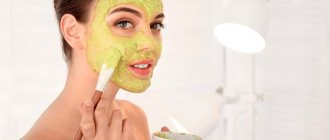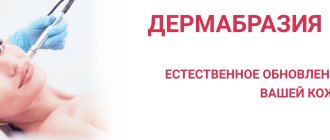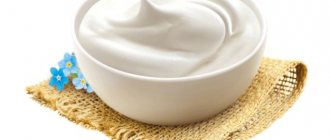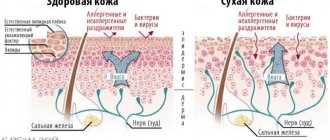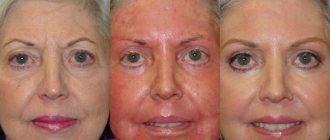Acne scars on the face are often the cause of dissatisfaction with one's own appearance and can cause the development of complexes. Cosmetologists and dermatologists have spent a lot of effort finding a way to clear the skin of scars and scars. The most effective method today is facial dermabrasion. The procedure is quite simple to perform, but it is performed exclusively in clinics equipped with special equipment.
About the method
Mechanical dermabrasion continues to be relevant today. The essence of the method is that the top layers are mechanically removed from the surface of the facial skin. The mechanical dermabrasion method is good because the depth of the skin layer removed is always under control
. During this procedure, only a fragment of the epidermis is removed (up to the layer with the papillae) and the upper part of the retinal dermis. The epidermis is the most superficial layer; it is where many keratinized, dead cells are located. With its papillae, the epidermis enters the denser dermal layer of the skin. Working with deeper layers is dangerous because you can deform the tissue and create a scar. Mechanical dermabrasion leaves the deep layers of the skin untouched and promotes rapid and high-quality skin regeneration.
Dermabrasion. general information
The word is made up of two Latin words: derma and abrasio. Literally translated it means scraping the skin. A special apparatus is used to treat the upper layers of the epidermis and remove old cells. Instead, new ones actively appear, and the regeneration process is stimulated.
In young cells, metabolic processes are carried out much more intensively. Thereby:
- the lack of collagen is compensated;
- the skin becomes softer;
- elasticity and relief are restored.
Today, the most popular is hardware dermabrasion, which involves the use of specialized instruments. Below we will consider the most effective method.
Scar removal
Scar removal using dermabrasion is a special topic. Firstly, a scar is a connective tissue that replaces a skin defect. Its properties differ from skin, which is sometimes very noticeable. Sometimes the scar protrudes too much above the surface of the skin, and sometimes it sinks too much inside. Scars are very noticeable on the skin, which often leads to dissatisfaction with one's appearance and psychological problems.
You can get rid of scars with early repeated dermabrasion
. Its essence is that the scar is “polished” in several stages depending on the degree of skin deformation. More than three stages in a row are not held. The interval between operations is seven to ten days. A repeated procedure is carried out until the skin is completely restored after the previous one. While the skin remains biosynthetically active, re-operation is more effective. Each new procedure makes the scar smaller. As a result, it may even disappear completely.
Keloid scars are eliminated in two stages.
The first is surgical excision by deep immobilization of local tissue. Next is mechanical grinding to the level of the skin. After this, it is imperative to carry out the so-called Bukki irradiation (short-focus radiation). It is absolutely safe, it is done even for children. The rays penetrate 1-2 mm into the skin and destroy the growth zone of the keloid.
Dermabrasion can also eliminate scars after burns.
. Although in this situation there are few cells for regeneration, since they die along with the rest of the tissue. It is necessary to produce secondary tension due to the restoration of the epidermis. Good results in this case can be achieved by smoothing and getting rid of hyperpigmentation.
History of origin
For the first time such a procedure – mechanical – appeared in 1949. Then a doctor from Germany named Schreuss started talking about the possibility of using special drills with perfect accuracy and increased rotation speed.
Schumann took up the development of the device - he created a small motor under the Diros brand, which was capable of producing the required number of revolutions. This is how the world's first skin resurfacing tool called Schuman Schreus appeared.
For more than thirty years, the device was almost the only way to remove:
- tattoos;
- scarring;
- dark spots.
However, it was not suitable for skin rejuvenation (especially on the face) for several reasons:
- increased pain;
- the likelihood of infection getting into the blood;
- long recovery period.
Cosmetologists and doctors continued to search for perfect methods. As a result of numerous studies, new devices were created that made it possible to universally introduce such a service as hardware dermabrasion. In addition, effective anesthesia and drugs for restoring the epidermis have appeared.
Operation time
Experts do not recommend performing skin surgeries from April to October.
If you perform surgery in the warm and hot season, then there is a risk of getting traumatic hyperpigmentation in the sun, in other words, darkening of the skin. People with dark skin color should especially be wary of this.
If you are referred to this procedure in the summer, assuring that with proper care there will be no complications, then most likely you have turned to an unqualified specialist.
It is better not to rush with such a procedure and not to take risks. Like many other skin surgeries, mechanical dermabrasion should be performed in late autumn or winter, when the sun is not active.
Note!
After the procedure, it is strictly forbidden to travel to southern countries for three months.
Post-procedure care
Microdermabrasion is not accompanied by a recovery period. However, we are talking about a violation of the skin, albeit minor. There are a number of rules that must be followed:
- Regardless of the time of year, avoid direct sunlight.
- Half an hour before going outside, apply sunscreen with a high SPF value to your face.
- Avoid visiting the pool, sauna, bathhouse, and swimming in open water for 5-7 days.
- It is recommended to reduce the intensity of physical activity to minimize sweating.
- At first, wash your face with warm water so as not to irritate the damaged dermis.
- Use cosmetic products that the specialist will recommend to you at the end of the session.
- Avoid aggressive cosmetics that contain alcohol and acids.
- Do not use decorative cosmetics - foundation, blush, compact and mineral powder.
You can make an appointment at the VOSK salon and find out prices by phone, during a personal visit or on the website. Online registration gives you the opportunity to receive a 15% discount on any procedure in one of our salons in Moscow.
Rehabilitation
An important aspect is skin care after the procedure. For the first four days, you should treat the wound with 40% alcohol, then be sure to lubricate it with a strong solution of potassium permanganate to form a clean and dry crust. It will protect the wound from infections. It is better to use potassium permanganate because it does not cause allergic reactions, does not contain antibiotics and does not have an unpleasant odor.
After the formation of a black crust on the fifth day, it must be softened. To do this, you can use any disinfectant ointment, for example, levomekol. On the seventh day, the doctor himself removes the crust. Next, the skin surface requires treatment with a solution of furatsilin and regenerating ointment until the area is completely healed.
Thus, if dermabrasion was carried out in one stage, the wound healing period will be 7-8 days. If the skin defect required several stages of polishing, then the rehabilitation period will extend depending on the number of stages.
Main indications
Dermabrasion is used to eliminate:
- scars, scars (after operations and burns);
- consequences of acne;
- stretch marks;
- decorative tattoos;
- spider veins;
- age spots;
- senile skin changes;
- wrinkles;
- enlarged pores;
- hyperpigmentation.
- The procedure is not recommended for:
- purulent inflammation;
- predisposition to the appearance of scars and keloids;
- epilepsy;
- tuberculosis;
- severe somatic diseases;
- poor blood clotting;
- renal and heart failure.
Laser resurfacing or mechanical?
Today there is a lot of debate about which grinding is more effective and safer - laser or mechanical.
First, mechanical dermabrasion is a painful operation that requires intravenous anesthesia. This significantly narrows the pool of potential patients. Thus, elderly people and people with pathologies of the cardiovascular system will not be able to afford mechanical resurfacing due to medical contraindications. For laser resurfacing, local anesthesia is sufficient, which does not have many contraindications and does not require long-term rehabilitation.
Some studies also note that laser resurfacing is less traumatic. Wounds after mechanical dermabrasion bleed more and take longer to heal than after laser dermabrasion.
In addition, the risk of infectious diseases during laser resurfacing is greatly reduced due to the fact that the instruments do not touch the surface of the skin. Plus, the thermal effect has an additional disinfecting effect.
Despite the seemingly obvious advantages of laser resurfacing, many dermatologists and dermatosurgeons have a negative attitude towards this technique and even consider it dangerous. The fact is that the laser emits a thermal effect that has not yet been studied today. Accordingly, no qualified specialist can fully predict all possible consequences and complications after this procedure.
What are the contraindications?
- Pregnancy and lactation;
- Pustular and viral skin lesions;
- Fresh scars;
- Diabetes;
- Tendency to form keloid scars;
- Epilepsy;
- A large number of moles and telangiectasias in the affected area;
- Infectious and viral diseases accompanied by fever;
- Fungal skin infection;
- Neoplasms benign and malignant;
- Sunburn;
- Allergic skin conditions;
- Fresh surgery;
- Bronchial asthma;
For those who have undergone a course of diamond facial resurfacing, it gives significant results in facial skin rejuvenation and aging prevention. For young patients of our center, this is a good way to deeply cleanse the skin of the face and give it a radiant appearance.
However, to combat more serious skin problems, we recommend turning to other, more aggressive cosmetic procedures.
What is it?
Facial cleansing is one of the most requested procedures from cosmetologists. The beauty industry does not stand still and creates more and more new services that allow women to look their best, regardless of age or lifestyle. It is a known fact that the condition of our skin is influenced by many factors. Poor lifestyle, stress, junk food - all this affects the condition of the epidermis. To give it a healthy look and improve the regeneration of the upper layers, cosmetologists advise using peelings and cleansing.
Microcrystalline dermabrasion or skin resurfacing is a loyal and painless method for removing dead skin cells and starting the process of dermis renewal. We can say that this service is a more advanced method of mechanical peeling.
What types are there?
At the moment, the beauty industry offers several types of dermabrasion:
- Diamond. The impact of diamond particles is applied. The method is used to combat pimples, wrinkles, scars, and pigmentation.
- Mechanical. It is considered the most profound and traumatic. Creates maximum rejuvenation effect, removes deep wrinkles, disguises scars.
- Microcrystalline dermabrasion. It is the mildest of the methods. Does not injure the skin, painless. Helps cope with the oiliness of the epidermis, smoothes out scars, dimples, and narrows enlarged pores.
Advantages and nuances of the service
Microdermabrasion is a cosmetic service that uses abrasive particles to exfoliate the skin. This method is universal and suitable for any skin type.
The main advantages of the method are:
- minimal trauma to the epidermis compared to other methods;
- can be used at home with properly selected products;
- short recovery period;
- Proper hydration prevents the skin from drying out;
- good for combating age-related restrictions, thanks to the launch of cell renewal;
- fights post-acne marks, removes dead skin cells;
- does not require large financial outlays;
- redness lasts only a couple of hours;
- leaves no scars.
The nuances of the service:
- Allergic reaction to certain components of the drugs.
Microcrystalline dermabrasion is able to polish the dermis thanks to the action of aluminum oxide crystals, which are considered the second hardest mineral after diamonds. Removing dead skin cells does not cause pain, clogging pores or causing irritation.

